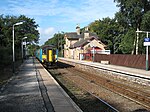Dove Holes Tunnel

Dove Holes Tunnel is a tunnel built by the Midland Railway between Peak Forest Signal Box and Chapel-en-le-Frith in Derbyshire in 1860–64, now carrying the Great Rocks Line. In the mid-nineteenth century, the Manchester, Buxton, Matlock and Midlands Junction Railway was jointly leased by the LNWR and Midland Railway, and ran as far as Rowsley. The Midland wished to extend to Manchester to give it a service to London but the LNWR, having its own London line, declined. It then supported the Stockport, Disley and Whaley Bridge Railway in building a line from Whaley Bridge to Buxton, one which the Midland considered unsuitable as a main line, due to its steep gradients over Cow Low. In the end, however, the Midland came to an agreement with the Manchester, Sheffield and Lincolnshire Railway that was formalised as the Sheffield and Midland Railway Companies' Committee. The Midland would extend its line to New Mills to meet a line the MS&LR was building from its main line out of Manchester. The Midland constructed a junction on its Buxton line at Peak Forest Signal Box which ran under Dove Holes in a tunnel 2,984 yards (2,729 m) long, some 183 feet (56 m) beneath the LNWR line. The entrance was at the summit of the line, nearly 1,000 feet (300 m) above sea level, and descended nearly a hundred feet at a gradient of 1 in 90.
Excerpt from the Wikipedia article Dove Holes Tunnel (License: CC BY-SA 3.0, Authors, Images).Dove Holes Tunnel
Meadow Lane, High Peak Chapel-en-le-Frith
Geographical coordinates (GPS) Address Nearby Places Show on map
Geographical coordinates (GPS)
| Latitude | Longitude |
|---|---|
| N 53.3079 ° | E -1.89641 ° |
Address
Meadow Lane
Meadow Lane
SK17 8DB High Peak, Chapel-en-le-Frith
England, United Kingdom
Open on Google Maps











